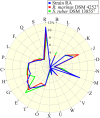Genome Analysis of a New Rhodothermaceae Strain Isolated from a Hot Spring
- PMID: 27471502
- PMCID: PMC4943939
- DOI: 10.3389/fmicb.2016.01109
Genome Analysis of a New Rhodothermaceae Strain Isolated from a Hot Spring
Abstract
A bacterial strain, designated RA, was isolated from water sample of a hot spring on Langkawi Island of Malaysia using marine agar. Strain RA is an aerophilic and thermophilic microorganism that grows optimally at 50-60°C and is capable of growing in marine broth containing 1-10% (w/v) NaCl. 16S rRNA gene sequence analysis demonstrated that this strain is most closely related (<90% sequence identity) to Rhodothermaceae, which currently comprises of six genera: Rhodothermus (two species), Salinibacter (three species), Salisaeta (one species), Rubricoccus (one species), Rubrivirga (one species), and Longimonas (one species). Notably, analysis of average nucleotide identity (ANI) values indicated that strain RA may represent the first member of a novel genus of Rhodothermaceae. The draft genome of strain RA is 4,616,094 bp with 3630 protein-coding gene sequences. Its GC content is 68.3%, which is higher than that of most other genomes of Rhodothermaceae. Strain RA has genes for sulfate permease and arylsulfatase to withstand the high sulfur and sulfate contents of the hot spring. Putative genes encoding proteins involved in adaptation to osmotic stress were identified which encode proteins namely Na(+)/H(+) antiporters, a sodium/solute symporter, a sodium/glutamate symporter, trehalose synthase, malto-oligosyltrehalose synthase, choline-sulfatase, potassium uptake proteins (TrkA and TrkH), osmotically inducible protein C, and the K(+) channel histidine kinase KdpD. Furthermore, genome description of strain RA and comparative genome studies in relation to other related genera provide an overview of the uniqueness of this bacterium.
Keywords: Longimonas; Rhodothermaceae; Rhodothermus; Rubricoccus; Rubrivirga; Salinibacter; Salisaeta; strain RA.
Figures


Similar articles
-
Complete genome sequence of Rhodothermaceae bacterium RA with cellulolytic and xylanolytic activities.3 Biotech. 2018 Aug;8(8):376. doi: 10.1007/s13205-018-1391-z. Epub 2018 Aug 13. 3 Biotech. 2018. PMID: 30105201 Free PMC article.
-
Heterologous expression, purification and biochemical characterization of a new endo-1,4-β-xylanase from Rhodothermaceae bacterium RA.Protein Expr Purif. 2019 Dec;164:105464. doi: 10.1016/j.pep.2019.105464. Epub 2019 Aug 1. Protein Expr Purif. 2019. PMID: 31376486
-
Rubricoccus marinus gen. nov., sp. nov., of the family 'Rhodothermaceae', isolated from seawater.Int J Syst Evol Microbiol. 2011 Sep;61(Pt 9):2069-2072. doi: 10.1099/ijs.0.026294-0. Epub 2010 Sep 17. Int J Syst Evol Microbiol. 2011. PMID: 20851913
-
Rhodobacter thermarum sp. nov., a novel phototrophic bacterium isolated from sediment of a hot spring.Antonie Van Leeuwenhoek. 2019 Jun;112(6):867-875. doi: 10.1007/s10482-018-01219-7. Epub 2019 Feb 23. Antonie Van Leeuwenhoek. 2019. PMID: 30798491
-
Draft Genome Sequence of Rubricoccus marinus SG-29T, a Marine Bacterium within the Family Rhodothermaceae, Which Contains Two Different Rhodopsin Genes.Genome Announc. 2017 Sep 21;5(38):e00990-17. doi: 10.1128/genomeA.00990-17. Genome Announc. 2017. PMID: 28935744 Free PMC article.
Cited by
-
Microbial CO2 fixation and biotechnology in reducing industrial CO2 emissions.Arch Microbiol. 2022 Jan 21;204(2):149. doi: 10.1007/s00203-021-02677-w. Arch Microbiol. 2022. PMID: 35061105 Review.
-
The core mangrove microbiome reveals shared taxa potentially involved in nutrient cycling and promoting host survival.Environ Microbiome. 2023 Jun 1;18(1):47. doi: 10.1186/s40793-023-00499-5. Environ Microbiome. 2023. PMID: 37264467 Free PMC article.
-
Characterizing a Halo-Tolerant GH10 Xylanase from Roseithermus sacchariphilus Strain RA and Its CBM-Truncated Variant.Int J Mol Sci. 2019 May 9;20(9):2284. doi: 10.3390/ijms20092284. Int J Mol Sci. 2019. PMID: 31075847 Free PMC article.
-
Global Transcriptomic Responses of Roseithermus sacchariphilus Strain RA in Media Supplemented with Beechwood Xylan.Microorganisms. 2020 Jun 29;8(7):976. doi: 10.3390/microorganisms8070976. Microorganisms. 2020. PMID: 32610703 Free PMC article.
-
Genome analysis of a thermophilic exopolysaccharide-producing bacterium - Geobacillus sp. WSUCF1.Sci Rep. 2019 Feb 7;9(1):1608. doi: 10.1038/s41598-018-36983-z. Sci Rep. 2019. PMID: 30733471 Free PMC article.
References
-
- Alfredsson G. A., Kristjansson J. K., Hjörleifsdottir S., Stetter K. O. (1988). Rhodothermus marinus, gen. nov., sp. nov., a thermophilic, halophilic bacterium from submarine hot springs in Iceland. Microbiology 134, 299–306. 10.1099/00221287-134-2-299 - DOI
-
- Blücher A., Karlsson E. N., Holst O. (2000). Substrate-dependent production and some properties of a thermostable, α-galactosidase from Rhodothermus marinus. Biotechnol. Lett. 22, 663–669. 10.1023/A:1005627501609 - DOI
LinkOut - more resources
Full Text Sources
Other Literature Sources
Miscellaneous

